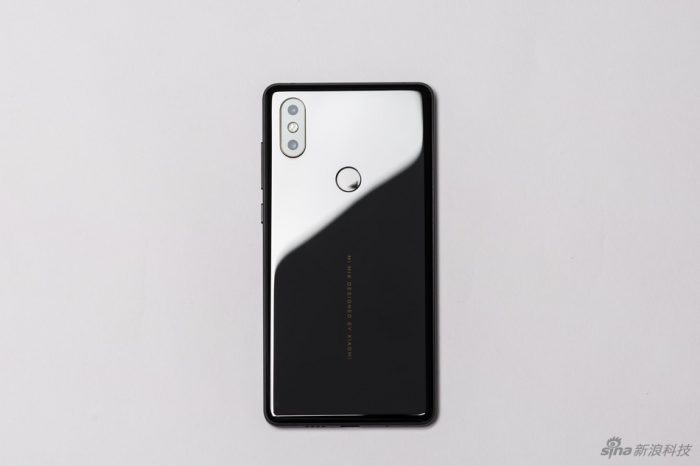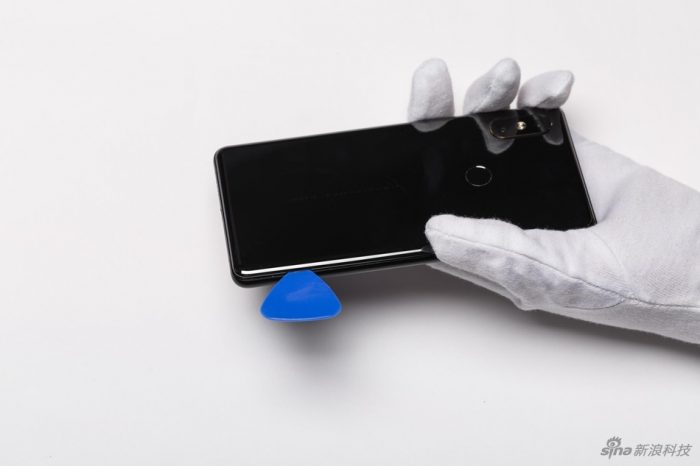Xiaomi has officially launched its Mi MIX 2S. This phone continues the design concept of the Mi MIX 2, and it boasts a full-screen with narrow bezels on both sides. The phone features a dual-rear vertical setup and a fingerprint reader on the back. The MIX 2S has a four-sided curved ceramic back panel to deliver an amazing hand feel.
Since it has an excellent appearance design, how about the workmanship on its internal design? Today, we will take apart the MIX 2S to explore its internal structure.

This is the rear design of the phone. It features a four-sided curved ceramic back panel with a delicate hand feel. The back is coated with an anti-fingerprint layer, which basically prevents fingerprint marks.

The ceramic back cover is surrounded by glue. Heat up and use a pick to remove the back cover.

When removing the ceramic battery cover, slowly open it from one side to avoid tearing the fingerprint ribbon cable. After removing the back cover, we can see a wireless charging coil. The NFC antenna is placed on the wireless charging coil.

On the inner side of the back cover, we found that it has some clips to secure it to the body.

This is a fingerprint reader module on the back cover.

The rear dual vertically-aligned camera lenses use scratch-resistant sapphire glass with a hardness of 9H. To enhance protection, the metal frame around the lenses is about 0.05 mm higher than the glass.

The ceramic back cover is made of a new tetragonal system ceramic material, which can effectively enhance the hardness of the phone.

After removing the cover, we can see that the graphite stickers are stacked in a double layer, covering almost all areas on the motherboard. This design is intended to enhance heat dissipation. In addition, the 3400mAh battery takes up a lot of space.

After taking out the motherboard and battery, a U-shaped groove is found on the motherboard. This part is reserved for the hidden earphone unit.

The main rear camera uses a 12MP Sony IMX363 sensor with a pixel size of 1.4 μm and supports four-axis optical image stabilization. Its secondary rear camera uses a 12MP Samsung S5K3M3+ sensor.

A copper foil layer is applied to the back of the dual rear camera module.

After removing the motherboard, we found a large hole where the main chip was placed to help improve heat dissipation. However, such a design can cause difficulties in processing.

The most important components on the motherboard, including the CPU and RAM, are covered with nanometer carbon copper, which has both heat dissipation and conductivity functions. This material can solve both heat dissipation and shielding problems.

It is the front of the motherboard. The white part on the left top corner is a voice-generating device of the ultrasonic distance sensor, and the semicircle part on the right is the receiver. The distance between the face and a phone can be calculated via a series of algorithms in this area.

The back of the motherboard.

Close-up of the back of the motherboard after removing the metal shields

After removing the 8GB LPDDR4 memory chip, the Snapdragon 845 processor becomes clearly visible.

The hidden earphone uses a 50mv large core. It will work as an auxiliary component for the loudspeaker to increase the volume.

Take out the earphones. It is the internal structure without the earphones.

Heat and remove the front panel. The front panel is designed with decorative strips to protect the LCD module and touchscreen.

We found that this front panel is made of PA high fiber with high intensity after using infrared spectroscopy to analyze it. Compared to glass fiber PC, the PA material has better hardness and dimensional stability. Xiaomi has enhanced the durability performance of its full-screen phones by incorporating this component.

We can see the internal structure of the hidden earphones and the ultrasonic distance sensor.
Now, let’s take a look at the core components of the phone. Throughout the teardown, we found that the Xiaomi Mi MIX 2S applies some new designs to its internal structure thanks to its full-screen design. Placing an ultrasonic system, high-power headphones, and dual rear cameras with OIS support in the cramped top space presents a great challenge for the phone.